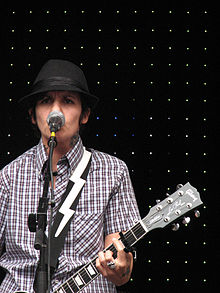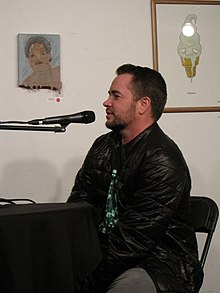Trans man

| Part of a series on |
| Transgender topics |
|---|
|
|
| Part of a series on |
| Boys and men |
|---|
 |
A trans man is a man who was assigned female at birth. The label of transgender man is not always interchangeable with that of transsexual man, although the two labels are often used in this way. Transgender is an umbrella term that includes different types of gender variant people (including transsexual people). Many trans men choose to undergo surgical or hormonal transition, or both (see sex reassignment therapy), to alter their appearance in a way that aligns with their gender identity or alleviates gender dysphoria.[1]
Although the literature indicates that most trans men identify as heterosexual (meaning they are sexually attracted to women),[2][3] trans men, like cisgender men, can have any sexual orientation or sexual identity, and some trans men might consider conventional sexual orientation labels inadequate or inapplicable to them, in which case they may elect to use labels like queer.[4]
Terminology[]


The term trans man is used as a short form for either identity (transsexual man and transgender man).[5] This is commonly referred to as female-to-male (FTM or F2M).[6] Transgender man is an umbrella term that may include anybody who was assigned female at birth (AFAB), but identifies as male.[7] For instance, some androgynous, bigender, and genderqueer people might identify as transgender.[5] Because transgender is an umbrella term, it can be imprecise and does not always describe specific identities and experiences.[8] Transmasculine is a general, broader term for individuals who were AFAB but identify closer to the masculine (or male) side of the gender spectrum.[9][10]
The term transsexual originated in the medical and psychological communities. However, unlike the term transgender, transsexual is not an umbrella term, and many transgender people do not identify as such.[11] Transsexual is a term for AFAB and assigned male at birth (AMAB) people alike who feel their sex organs do not reflect their gender and have chosen to change some aspect of their body; it is an older term, with GLAAD stating that it is "still preferred by some people who have permanently changed – or seek to change – their bodies through medical interventions (including but not limited to hormones and/or surgeries)."[11] The transgender community sometimes uses the term passing to describe a transgender person's ability to appear as the gender they identify with. The opposite meaning is conveyed by the terms "to be read" or "to be clocked", and means not passing.[12]
Transitioning[]



Originally, the term trans men referred specifically to female-to-male transsexual people who underwent hormone replacement therapy (HRT) or sex reassignment surgery (SRS), or both. The definition of transition has broadened to include theories of psychological development or complementary methods of self-acceptance.[8][13] Many of those who identify as transgender may face gender dysphoria.
Transsexual and transgender men may seek medical interventions such as hormones and surgery to make their bodies as congruent as possible with their gender presentation. However, many transgender and transsexual men cannot afford or choose not to undergo surgery or hormone replacement therapy.
Many who have not undergone top surgery choose to bind their breasts. There are a few different methods of binding, including using sports bras and specially made binders (which can be vest-type, or wrap-around style). Tape or bandages are often depicted in popular culture.
Some trans men might also decide to pack, to create a phallic bulge in the crotch of clothing. However, this is not universal. Trans men who decide to pack may use anything from rolled up socks to specially made packers, which resemble a penis. Some packers are also created for trans men to be able to urinate through them (stand-to-pee, or STP, devices), or for sexual penetration or other sexual activity (known as "pack-and-play").
Transitioning might involve some or all of the following steps:[14]
- Social transition: using a preferred name and pronouns, wearing clothing seen as gender appropriate, disclosure to family, friends and usually at the workplace/school.
- Sex reassignment therapy: hormone replacement therapy (HRT), and/or surgery (SRS)[15]
- Legal affirmation: name and (sometimes) sex marker correction in legal identification documents.[16][17]
Being socially accepted as male (sometimes known as passing) may be challenging for trans men who have not undergone HRT and/or surgery.[16][17] Some trans men may choose to present as female in certain social situations (e.g. at work).[16][17] After physical transition, trans men usually live full-time as male.[16][17] However, some transmasculine individuals might choose to use and engage their bodies to be pregnant, birth a baby, and breastfeed.[9]
Prevalence, identity and relationships[]
In the United States, the ratio of trans men within the general population is unclear, but estimates range between 1:2,000 and 1:100,000.[18][19][20] A U.S. Census Bureau study in 2015 suggests that there were around 58,000 name changes in census records consistent with female to male transitions although only 7,500 of these changed their sex coding as well.[21]
In a study by Kara Devaney, entitled Transgender Research Literature Review, it is addressed that the term transgender encompasses a myriad of different and unique identities that do not follow the "normal" rules of gender. Miriam J. Abelson writes, "There is no question that trans men's experiences are men's experiences and give insight about men, masculinity, and gender inequality."[22]
A trans man may have any sexual orientation or sexual identity, and some trans men consider conventional sexual orientation labels inadequate or inapplicable to them.[23] The literature commonly indicates that sexual attraction to those of their same gender (e.g., trans men liking men and trans women liking women) is considerably less common among trans men than among trans women; the vast majority of trans men are reported as heterosexual.[2][3] Surveys from the National Center for Transgender Equality show more variation in sexual orientation or sexual identity among trans men. In NCTE's 2015 Transgender Survey of respondents who identified as trans men, 23% identified as heterosexual or straight. The vast majority (65%) identified their sexual orientation or sexual identity as queer (24%), pansexual (17%), bisexual (12%), or gay/same-gender loving (12%).[24]
Some trans men date heterosexual women, while other trans men date queer-identified women; the latter might be because queer-identified women are less invested in the gender and sexual anatomy of a person when it comes to selecting an intimate partner.[3] It is also common for trans men to have histories with the lesbian community or to feel that they identify better with that community because of its wide acceptance of gender variance, with a number of trans men having identified as lesbian (often as a "butch lesbian") before realizing that they are instead transgender.[2][3][25]
Trans men have less success integrating socially within cisgender gay men's communities, which tend to be more body-focused, especially in terms of being phallocentric.[3][26][27] Yitzchak et al. state that, as a result, they more commonly see gay trans men partnering with each other than with cisgender gay men.[3] There are, however, cases of women being likelier than men to thoroughly question trans men about their motivations for modifying their bodies.[26]
Some scholars argue against assumptions that trans men are predominantly heterosexual and usually have lesbian histories. In scholars Ian Irving and Rupert Raj's book Trans Activism in Canada, researchers state, "There is still a common misperception that trans men are largely heterosexual amongst those who conflate gender identity and sexual orientation. It is frequently assumed that trans men are exclusively attracted to women and have lesbian histories prior to transition." They add, "Recent data from the Trans PULSE project (Bauer, Redman, Bradley, & Scheim, 2013) challenge this assumption, with 63 percent of female-to-male spectrum trans people in Ontario reporting non-heterosexual identities and/or past-year sex with trans or non-trans men." They also argue that, based on some research, "many non-trans gay men have welcomed trans men into gay communities and have increasingly recognized trans men as potential sexual and romantic partners."[28]
Sexual violence[]
Trans men can be victims of sex crimes, and there are cases where rape has occurred, including with the intention of changing the sexual expressions and/or the sexuality of trans men; this is known as corrective rape. In a 2016 Bangkok Post article, a researcher stated, "Unlike in South Africa, where homophobic rape is rampant, with increasing trends as a large number of men still want to use violence to force trans people to abandon their sexual identity, there are no official surveys or studies about this problem in Thailand. [...] Recently some video clips emerged showing the rape of trans people." Furthermore, the article told about two cases of rape of trans men in Thailand, and a claim that "it seems that quite a few people [in Thailand] would say they have heard of, or known about, such cases in their communities".[29]
Health[]
Accessing health care services for trans men can be difficult.[30] HIV infection between trans men and others is still increasing.[31]
Trans men may or may not menstruate, depending on their individual circumstances.[32]:1
Discrimination[]
Transgender men can face discrimination as a result of their status as trans men. Such discrimination may include sexual violence.[29]
Films[]
- My Dearest Senorita, 1972, Spain, drama
- Shinjuku Boys, 1995, Japan, documentary about three transmen working in a host-club in Shinjuku, Tokyo
- Boys Don't Cry, 1999, US, drama (based on real story)
- Southern Comfort, 2001, US, documentary
- TransGeneration, 2005, US, documentary miniseries
- Transparent, 2006, US, documentary
- Pick Up the Mic, 2006, US, documentary (features two FTM artists)
- My Friend from Faro, 2008, Germany, drama
- STILL BLACK: a portrait of black transmen, 2008, US, documentary about black trans men
- Loop Planes, 2010, US, short drama[33]
- Becoming Chaz, 2011, US, documentary about Chaz Bono's transition
- Romeos, 2011, Germany, drama
- Facing Mirrors, 2011, Iran, drama
- 52 Tuesdays, 2013, Australia, drama
- Songs For Alexis, 2014, US, documentary about Ryan Cassata[34][35]
- 3 Generations, 2015, US, drama
- Real Boy, 2016, US, documentary about Ben Wallace and Joe Stevens[36]
- Beemus, It'll End In Tears, 2016, US, short drama[37]
- Jack and Yaya, 2019, documentary about lifelong friends who both transitioned[38]
- Colors of Tobi, 2021, Hungary
See also[]
- Trans woman
- List of transgender people
- List of transgender-related topics
References[]
- ^ Bariola, Emily; Lyons, Anthony; Leonard, William; Pitts, Marian; Badcock, Paul; Couch, Murray (October 2015). "Demographic and Psychosocial Factors Associated With Psychological Distress and Resilience Among Transgender Individuals". American Journal of Public Health. 105 (10): 2108–2116. doi:10.2105/AJPH.2015.302763. PMC 4566567. PMID 26270284.
- ^ Jump up to: a b c Michael Shankle (2013). The Handbook of Lesbian, Gay, Bisexual, and Transgender Public Health: A Practitioner's Guide to Service. Routledge. p. 175. ISBN 978-1-136-57355-2. Retrieved January 10, 2016.
- ^ Jump up to: a b c d e f Yitzchak M. Binik, Kathryn S. K. Hall (2014). Principles and Practice of Sex Therapy, Fifth Edition. Guilford Publications. p. 252. ISBN 978-1-4625-1389-5. Retrieved January 10, 2016.CS1 maint: uses authors parameter (link)
- ^ Bockting, Walter; Benner, Autumn; Coleman, Eli (28 March 2009). "Gay and Bisexual Identity Development Among Female-to-Male Transsexuals in North America: Emergence of a Transgender Sexuality". Archives of Sexual Behavior. 38 (5): 688–701. doi:10.1007/s10508-009-9489-3. PMID 19330439. S2CID 27207925.
- ^ Jump up to: a b "what are Answers to Your Questions About Transgender Individuals and Gender Identity". APA. Retrieved Jan 26, 2015.
- ^ Swann, William B.; Gómez, Ángel; Vázquez, Alexandra; Guillamón, Antonio; Segovia, Santiago; Carillo, Beatriz (10 February 2015). "Fusion with the Cross-Gender Group Predicts Genital Sex Reassignment Surgery". Archives of Sexual Behavior. 44 (5): 1313–1318. doi:10.1007/s10508-014-0470-4. PMID 25666854. S2CID 3261825.
- ^ Carabez, Rebecca; Pellegrini, Marion; Mankovitz, Andrea; Eliason, Mickey; Scott, Megan (November 2015). "Does your organization use gender inclusive forms? Nurses' confusion about trans* terminology". Journal of Clinical Nursing. 24 (21–22): 3306–3317. doi:10.1111/jocn.12942. PMID 26263919.
- ^ Jump up to: a b "Hudson's Guide: FTM Basics: Terminology". Ftmguide.org. Retrieved 2015-02-22.
- ^ Jump up to: a b MacDonald, Trevor; Noel-Weiss, Joy; West, Diana; Walks, Michelle; Biener, MaryLynne; Kibbe, Alanna; Myler, Elizabeth (16 May 2016). "Transmasculine individuals' experiences with lactation, chestfeeding, and gender identity: a qualitative study". BMC Pregnancy and Childbirth. 16 (1): 106. doi:10.1186/s12884-016-0907-y. PMC 4867534. PMID 27183978.
- ^ "the definition of transmasculine". Dictionary.com. Retrieved 2016-09-08.
- ^ Jump up to: a b "GLAAD Media Reference Guide – Transgender". GLAAD. 2011-09-09. Retrieved 30 August 2017.
- ^ Ennis, Dawn (4 February 2016). "10 Words Transgender People Want You to Know (But Not Say)". Advocate.com. Retrieved 29 June 2017.
- ^ "Glossary". Huc.edu. Archived from the original on 2014-05-19. Retrieved 2015-02-22.
- ^ Ftmaustralia.org Archived July 25, 2008, at the Wayback Machine
- ^ Meriggiola, Maria Cristina; Gava, Giulia (November 2015). "Endocrine care of transpeople part I. A review of cross-sex hormonal treatments, outcomes and adverse effects in transmen". Clinical Endocrinology. 83 (5): 597–606. doi:10.1111/cen.12753. PMID 25692791. S2CID 11480289.
- ^ Jump up to: a b c d Lev, Arlene Istar (2004). Transgender Emergence: Therapeutic Guidelines for Working with Gender-Variant People and their Families. Routledge. ISBN 978-0-7890-2117-5.
- ^ Jump up to: a b c d Eno, Amanda (1 March 2008). "The Misconception of Sex in Title VII: Federal Courts Reevaluate Transsexual Employment Discrimination Claims". Tulsa Law Review. 43 (3): 765–792.
- ^ Conway, Lynn (April 2, 2012). "Estimating the Prevalence of Transsexualism".
- ^ Joanne Herman (2006-05-11). "There are more of us than you think". Advocate.com. Retrieved 2015-02-22.
- ^ Msu.edu Archived May 20, 2008, at the Wayback Machine
- ^ Likely Transgender Individuals in U.S. Federal Administrative Records and the 2010 Census Archived 2017-01-12 at the Wayback Machine Census.gov
- ^ Abelson, Miriam (17 October 2014). Men in Context: Transmasculinities and Transgender Experiences in Three US Regions (Thesis). hdl:1794/18512.
- ^ "Sexual Orientation and Gender Identity Definitions". Human Rights Campaign.
- ^ James, S.E.; Herman, J.L.; Rankin, S.; Keisling, M.; Mottet, L.; Anafi, M. "The Report of the 2015 U.S. Transgender Survey" (PDF). 2015 US Transgender Survey. National Center for Transgender Equality. Retrieved 1 June 2018.
- ^ George Haggerty, Bonnie Zimmerman (2003). Encyclopedia of Lesbian and Gay Histories and Cultures. Taylor & Francis. p. 776. ISBN 978-1-135-57870-1. Retrieved January 10, 2016.CS1 maint: uses authors parameter (link)
- ^ Jump up to: a b Kristen Schilt (2010). Just One of the Guys?: Transgender Men and the Persistence of Gender Inequality. University of Chicago Press. p. 153. ISBN 978-0-226-73807-9. Retrieved January 10, 2016.
- ^ Sumerau JE, Mathers L (2019). America through Transgender Eyes. Rowman & Littlefield. pp. 60–61. ISBN 978-1538122082.
- ^ Ian Irving, Rupert Raj (2014). Trans Activism in Canada: A Reader. Canadian Scholars' Press. p. 248. ISBN 978-1-55130-537-0. Retrieved January 10, 2016.CS1 maint: uses authors parameter (link)
- ^ Jump up to: a b Sulaiporn Chonwilai (17 May 2016). "Trans community still faces violence". Bangkok Post.
- ^ Alencar Albuquerque, Grayce; de Lima Garcia, Cintia; da Silva Quirino, Glauberto; Alves, Maria Juscinaide Henrique; Belém, Jameson Moreira; dos Santos Figueiredo, Francisco Winter; da Silva Paiva, Laércio; do Nascimento, Vânia Barbosa; da Silva Maciel, Érika; Valenti, Vitor Engrácia; de Abreu, Luiz Carlos; Adami, Fernando (14 January 2016). "Access to health services by lesbian, gay, bisexual, and transgender persons: systematic literature review". BMC International Health and Human Rights. 16 (1): 2. doi:10.1186/s12914-015-0072-9. PMC 4714514. PMID 26769484.
- ^ Tang, Songyuan; Tang, Weiming; Meyers, Kathrine; Chan, Polin; Chen, Zhongdan; Tucker, Joseph D. (20 October 2016). "HIV epidemiology and responses among men who have sex with men and transgender individuals in China: a scoping review". BMC Infectious Diseases. 16 (1): 588. doi:10.1186/s12879-016-1904-5. PMC 5073436. PMID 27765021.
- ^ Frank, S. E.; Dellaria, Jac (2020), Bobel, Chris; Winkler, Inga T.; Fahs, Breanne; Hasson, Katie Ann (eds.), "Navigating the Binary: A Visual Narrative of Trans and Genderqueer Menstruation", The Palgrave Handbook of Critical Menstruation Studies, Singapore: Springer Singapore, pp. 69–76, doi:10.1007/978-981-15-0614-7_7, ISBN 978-981-15-0613-0, PMID 33347161
- ^ "Loop Planes". frameline.org. 2010.
- ^ "Songs For Alexis". frameline.org. 2014.
- ^ Bausells, Marta (14 April 2015). "How to fight trans invisibility in film". The Guardian.
- ^ "Real Boy". PBS. 2017.
- ^ "Watch: Beemus, It'll End in Tears, from Lauren Wolkstein and Frances Bodomo". Film Maker Magazine. 2016.
- ^ "Trans Friends Grow Up Together, Trade Toys in New Doc 'Jack & Yaya'". www.advocate.com. 2019-05-28. Retrieved 2019-12-09.
Further reading[]
- Becoming a Visible Man by Jamison Green
- Just Add Hormones: An Insider's Guide to the Transsexual Experience by Matt Kailey
- Transmen and FTMs: Identities, Bodies, Genders, and Sexualities by
- FTM: Female-to-Male Transsexuals in Society. by Aaron H. Devor
- Second Son: Transitioning Toward My Destiny, Love and Life by Ryan Sallans
External links[]
- Transman at Curlie
- Medical Therapy and Health Maintenance for Transgender Men: A Guide For Health Care Providers free ebook, ISBN 0-9773250-0-8
- TransGuys.com A magazine for trans men
- FTM International An organization serving the female-to-male trans community.
- Original Plumbing magazine Quarterly magazine with online component focusing on culture and diversity in the trans male community.
- Trans men
- Transgender and transsexual men
- Terms for men
- Transgender identities
- Transgender